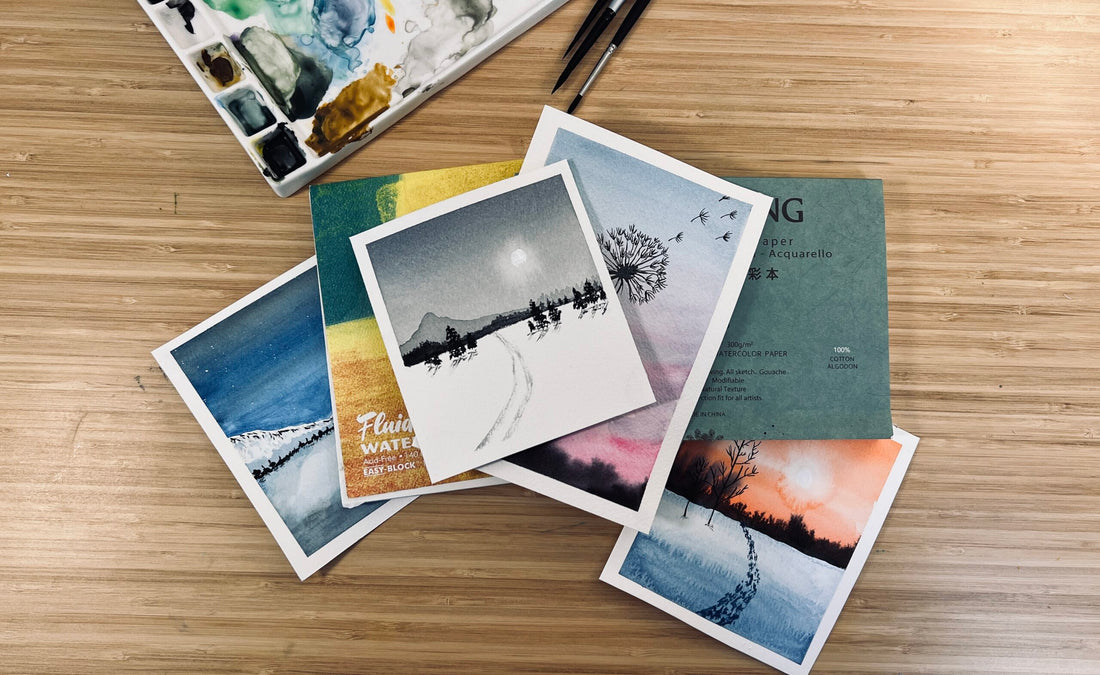
Cold Press vs Hot Press Watercolor Paper: What You Need to Know
Share
You know that moment when you’re standing in the art supply store, staring at rows of watercolor paper, wondering which one to choose? I’ve been there too. After years of painting and teaching watercolor workshops, I’ve learned that choosing between cold press and hot press paper doesn’t have to be complicated. Let’s break it down together!
What’s the Difference Between Cold Press and Hot Press Paper?
The main difference comes down to texture. Cold press paper has a slightly bumpy, textured surface (think orange peel), while hot press paper is smooth as glass. But there’s so much more to consider when choosing between these two popular options.
Cold Press Watercolor Paper
- Has a medium texture with small dimples and raised areas
- Most popular choice for watercolor artists
- Excellent for both beginners and experienced painters
- Holds water well without warping
- Creates beautiful granulation effects
- Perfect for most watercolor techniques
Hot Press Watercolor Paper
- Smooth, flat surface with minimal texture
- Preferred by illustrators and artists doing detailed work
- Excellent for sharp lines and fine details
- Dries faster than cold press
- Creates crisp edges and clean washes
- Ideal for combining with other mediums
How They’re Made (And Why It Matters)
As you may have guessed, the names “cold press” and “hot press” actually come from the manufacturing process. Both papers start out the same way, but their final treatment creates their distinct personalities.
Cold Press Process:
- Paper is pressed between felt-covered rollers
- No heat is applied during pressing
- Creates that characteristic subtle texture
- Results in more absorbent surface
Hot Press Process:
- Paper is pressed between heated metal rollers
- Heat and pressure create smooth surface
- Fibers are compressed more tightly
- Creates less absorbent surface
When to Choose Cold Press Paper
Cold press is my go-to paper for most watercolor projects. I especially like using cold press “blocks” and even dedicated an entire post to raving about my fave in this Baohong Watercolor Block review. Here’s when cold press really shines:
- Landscape Paintings: The texture creates natural-looking effects for rocks, trees, and clouds
- Loose Watercolor Techniques: Perfect for wet-in-wet and letting colors blend naturally
- Learning New Techniques: Forgiving surface that handles water well
- Building Layers: Texture helps create depth and interest
- Traditional Watercolor Look: Creates that classic watercolor appearance

When to Choose Hot Press Paper
Hot press paper is like that sophisticated friend who excels at specific things. I reach for hot press when:
- Botanical Illustrations: Perfect for precise leaf veins and delicate details
- Architectural Drawings: Creates clean, sharp lines
- Portrait Work: Allows for fine facial details
- Mixed Media Projects: Takes well to pen, pencil, and other mediums
- Commercial Art: Scans beautifully for reproduction
Paper Weight Matters Too
While deciding between cold and hot press, don’t forget about paper weight. Here’s what I recommend:
- 140 lb (300 gsm): Standard weight, good for most projects (This is what I use).
- 300 lb (638 gsm): Professional grade, minimal buckling, no stretching needed
- 90 lb (190 gsm): Fine for sketches and practice, but will buckle
My Top Recommendations
After trying countless papers, here are my favorite options:
Best Cold Press Papers:
- Baohong Cold Press Block – My everyday go-to
- Arches Cold Press 140 lb – When I’m not using a block, I reach for this paper
- Arches 300 lb 9×12 Block – This is a great option when you want to sell watercolor paintings, the paper does not warp and has a lovely texture
- Leather Village Rough Edge Paper – I love the look of this rough edge paper
Best Hot Press Papers:
- Arches Hot Press 140 lb – Superior smooth surface
- Meeden Hot Press Watercolor Block – Great if you don’t want to tape down your work, affordable
- Magnani 1404 Portofino 300 lb Block – Very high-quality, suitable for selling

Common Questions About Watercolor Paper
Q: Can beginners use hot press paper?
A: While beginners can use any paper, I recommend starting with cold press. It’s more forgiving and better suited for learning basic techniques.
Q: Does hot press paper dry faster?
A: Yes! The smooth surface means water sits on top rather than settling into texture, resulting in faster drying times.
Q: Is cold press more expensive?
A: Generally, cold press and hot press papers from the same manufacturer cost the same. The price difference comes from brand and weight rather than texture.
Tips for Success with Both Papers
- Sample First: Try small sheets or blocks before investing in full sheets
- Storage Matters: Store flat and away from humidity
- Test Your Techniques: What works on cold press might need adjusting on hot press
- Consider Your Style: Match the paper to your painting style
- Quality Counts: Invest in the best paper you can afford – it makes a difference!
Final Thoughts
Remember, there’s no “right” choice between cold press and hot press paper – it’s about finding what works best for your style and projects. Start with cold press if you’re new to watercolor, but don’t be afraid to experiment with hot press as you develop your skills.
The joy of watercolor comes from exploration and finding what feels right for you. Whether you choose the reliable texture of cold press or the smooth sophistication of hot press, the most important thing is to start painting and let your creativity flow!
Happy painting!
P.S. Have questions about watercolor paper? Drop them in the comments below – I’d love to help!
